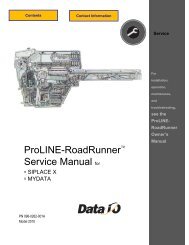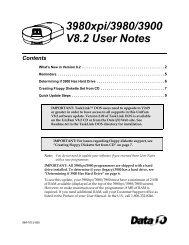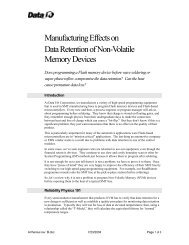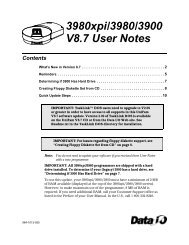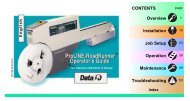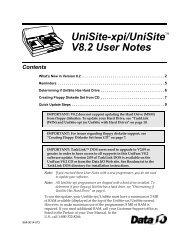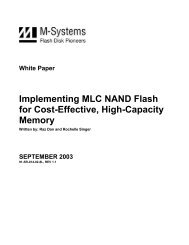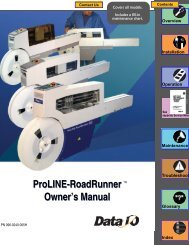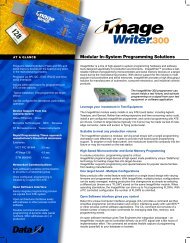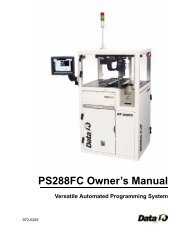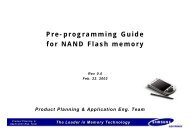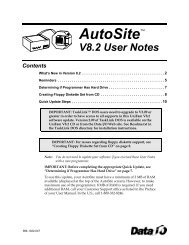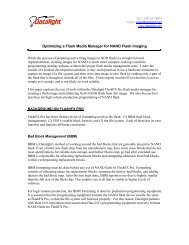3980xpi Users Manual - Data I/O Corporation
3980xpi Users Manual - Data I/O Corporation
3980xpi Users Manual - Data I/O Corporation
You also want an ePaper? Increase the reach of your titles
YUMPU automatically turns print PDFs into web optimized ePapers that Google loves.
Translation Formats<br />
RCA Cosmac Format, Code 70<br />
<strong>Data</strong> in this format begins with a start record consisting of the start character<br />
(!M or ?M), an address field, and a space. See Figure 5-7.<br />
Figure 5-7. RCA Cosmac Format (example)<br />
Start Record<br />
!M or ?M = Start Characters<br />
0000 = Address<br />
!M0000 ,<br />
FFFFFFFFFFFFFFFFFFFFFFFFFFFFFFFF,<br />
FFFFFFFFFFFFFFFFFFFFFFFFFFFFFFFF,<br />
FFFFFFFFFFFFFFFFFFFFFFFFFFFFFFFF,<br />
FFFFFFFFFFFFFFFFFFFFFFFFFFFFFFFF,<br />
FFFFFFFFFFFFFFFFFFFFFFFFFFFFFFFF<br />
End-of-File Record<br />
LEGEND<br />
1 Nonprinting line feed, carriage return, and nulls<br />
2 Nonprinting carriage return<br />
The start character?M is sent to the programmer by a development system,<br />
followed by the starting address, and a data stream which conforms to the<br />
data input format described in the ASCII-Hex and Octal figure. Transmission<br />
stops when the specified number of bytes has been transmitted.<br />
Address specification is required for only the first data byte in the transfer. An<br />
address must have 1 to 4 hex characters and must be followed by a space. The<br />
programmer records the next hexadecimal character after the space as the<br />
start of the first data byte. (A carriage return must follow the space if the start<br />
code ?M is used.) Succeeding bytes are recorded sequentially.<br />
Each data record is followed by a comma if the next record is not preceded by<br />
an address, or by a semicolon if it starts with an address. Records consist of<br />
data bytes expressed as 2 hexadecimal characters and followed by either a<br />
comma or semicolon, and a carriage return. Any characters received between<br />
a comma or semicolon and a carriage return will be ignored by the<br />
programmer.<br />
The carriage return character is significant to this format because it can signal<br />
either the continuation or the end of data flow; if the carriage return is<br />
preceded by a comma or semicolon, more data must follow; the absence of a<br />
comma or semicolon before the carriage return indicates the end of<br />
transmission.<br />
Output data records are followed by either a comma or a semicolon and a<br />
carriage return. The start-of-file records are expressed exactly as for input.<br />
5-16 <strong>3980xpi</strong>/3980/3900/2900 User <strong>Manual</strong><br />
1<br />
2<br />
<strong>Data</strong> Records<br />
FF = 2 Hex Characters = (1 Byte)<br />
Bytes per record is variable<br />
, = End of Record Character<br />
; = End of Record Character<br />
if followed by expressed<br />
address<br />
0079-2




